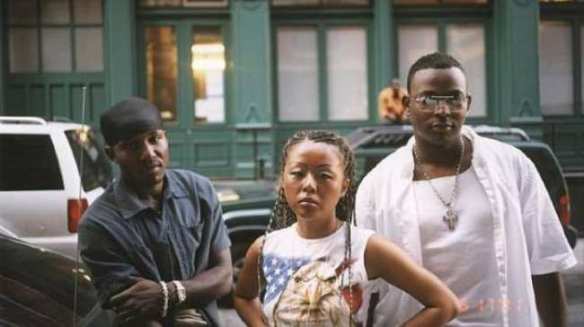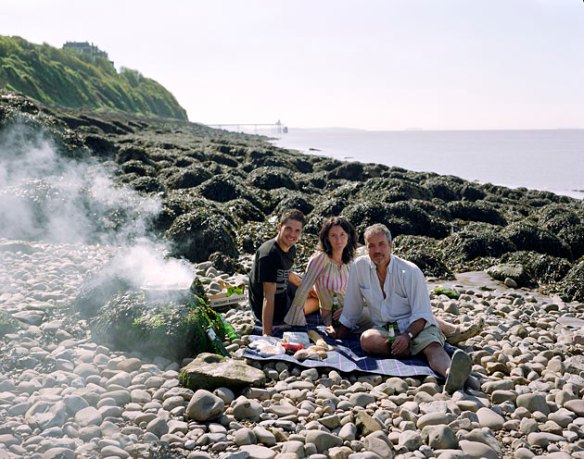10/09/18
Many artists, including photographers, use self-portraiture to talk about someone else or something else. They may dress up as a different person and insert themselves into the scene as Lee and Morrissey do. They may mimic the other person directly (Moffatt) or act out a series of roles for a personal or political reason such as the work of Tracey Rose in Ciao Bella where she adopts personas that comment both on her upbringing and the idea of national identity both in the past and present.
Nikki S Lee (born 1970) is a Korean-American photographer. In her work Projects she transforms herself, by using make-up, dressing-up and copying of stances to appear as an alternate identity from a series of different cultures and sub-cultures. She then has images taken of herself with a group from this subculture. On the face of it Lee turns herself into a person from another race or culture. Is she really assimilated? Lee apparently took on all the different identities she used, learning to skate and strip, getting involved with groups of young people and those much older than herself. In an interview she says, “I like to have many different layers in my artwork… the more you think about it the harder it is to interpret” (YouTube, 2015). In another series Parts she took images of people she was close to, and then cut them out of the image – leaving a part of an image, leaving the other half to your imagination. In Layers she had street artists from across the world draw her face, she then layered three of the images together to look at how people from different cultures would see her face, looking for the various layers of personality that everyone has. Lee is interested in the idea of performance, rather than reality and also in involving other people in her art. She says “The work I do always needs to involve others…. Because of my views about my own identity…. I couldn’t understand who I am without the people around me”. (YouTube, 2015) and also “I am interested in identity as it is affected or changed though social contexts, cultural categories or personal relationships…. I changed between my surroundings…. Depending on whether I was with my family or friends” (Bright, 2010).

© Nikki S Lee
Views on her work vary. Most people see it as a fascinating take on the way your identity changes with how you dress, who you are with in an image and who is taking (or making) an image of you. Other people see it as insulting to the sub-cultures to pretend to be part of them and to make money (and your reputation) from doing so. Lee (and her fans) would argue that what she is showing is that identity is mutable, that images only ever show part of you and by changing how you appear in an image you are showing an alternative side of yourself. Her images are certainly very convincing. If you are not looking for her face very carefully, it is often difficult to pinpoint who she is, although she is often, but not always the central character. A google search for the images shows a plethora of images that are reminiscent of those that are taken by any group of people on a day out or at a gathering with friends. Is it exploitative? The other people in the images usually look as though they are having fun – but is that enough? It is impossible to tell from the images what degree of informed consent was asked for. No names are given. Do the other people share in her monetary gains? Are they given copies of the images? Is it reasonable to dress up as a person from another culture? There are several on-line comments about her use of making up in ‘brown-face’ make-up suggesting that it is racially abusive and that it uses characterisations of people without any depth or subtlety.
I find her work interesting but uncomfortable. It shows how easy it is to become someone else on the surface but is it showing anything about the underlying person? I am not sure that it is.
Trish Morrissey, in her series Front took images on the beach where she approached families and asked if she could become ‘one of them’ for a photo. Morrissey would borrow clothes or items from the mother figure in the group, join the group and then get the woman she had replaced to take the photograph. She says “Front deals with the notions of borders, boundaries and the edge …. shaped by chance encounters with strangers” (Bright, 2010). She recognises the role of the woman she has replaced by titling the image with the woman’s name and the date. The groups of people are described as randomly chosen from those she has come across, but, in reality, are clearly carefully picked. The majority of the groups are attractive, and although they mimic a family beach photo they have a posed quality. There are no odd bits do rubbish, limbs half amputated, people looking away, children arguing, sulky teenagers. What is she showing? Is it the universal nature of a type of family holiday? Does it ‘matter’ that the central figure is a cuckoo in the nest?

© Trish Morrissey, June Marsh, October 15th, 2007
In another series, Seven Years, Morrissey and her sister acted to recreate moments from their childhood, to produce a family album of the type that was prevalent last century, before the onset of digital images and photo-sharing websites. These images were often highly stylised, with best clothes, photo faces and would represent important moments in the families lives, birthdays, meetings with rarely seen relatives, births and deaths. The photographs in the albums were the best ones, the mistakes either thrown away or shoved randomly in a box, to be giggled over at a later date by a younger generation. The images in Seven Years are those types of images, here she does show the random arm, the person turning away, the ungainly pose. Morrissey is again pretending to be someone else, but in this case the pretence is nearer to home, with a sharper edge.
In The Failed Realist Morrissey shows a series of images of her face which has been painted by her young daughter. She says ‘she wanted to paint me rather than be painted….and would decide to paint something from her immediate experience….a movie, a social event, a right of passage, or a vivid dream’ (Trishmorrissey.com, 2018). She reprised this series 6 years later in The Successful Realist with how now 11 year old daughter, with much improved painting skills making her mother up as more specific images from her experience of life as a just pre-teen. In both cases her daughter painted Morrisey’s face to represent parts of the child’s world. What does this say about Morrissey herself? Is she taking on another persona? Is it a return to the innocence of childhood? The simple fact that Morrissey encourages her daughter to do this and then takes and publishes the images implies that she has a marked degree of self-confidence, but also that however much you change your outward appearance something of the inward person shows though.
Tracey Moffatt in Under the Sign of Scorpio explores what it is like to be born a Scorpio by re-imagining herself as forty famous women who were also born under that star sign. In a fascinating essay by Moffatt on this series (Moffatt, 2005) she talks about the amount of research she had to do to become the people she then dressed as, how she took the images and her theory about talent ‘This brings me to the subject of willpower, psychic ability, and – God forbid I mention it – witchcraft and magic. It is my theory that ‘talent’ is a supernatural force that cannot be explained. This also applies to astonishing athletic ability’ and about her feelings about being a Scorpio ‘Since I was born on November 12th and am also a Scorpio, I have been intrigued about what makes the Scorpio tick. It is such a powerful and intense sign: Scorpios can ‘cross over’ into dark worlds and come back unscathed. They are fearless and listen to no-one……In speaking of frightening energies – at this stage I have told very few of the Scorpio women that I have included them in this photo series (I have met about eight of them). The last thing one should do is flatter a Scorpio; they immediately get suspicious, and depending on their mood, will hate your guts for it. It has taken me years to learn to graciously accept a compliment.’(Moffatt, 2005). The final images themselves are highly coloured, in many you do not see the face, for instance in the one of Nadia Comaneci (Russian gymnast) you just see her hands mimicking one of Comaneci’s famous poses. The images echo the person’s life but could not be mistaken for a photograph of them. They add to the mythos around the person. However, she also shows the process, the contact sheets and her studio, where the emphasis seems to be more on her becoming the woman and are more obviously a picture of Moffatt dressing up than of an icon. The process of the pretence is clearly important to Morrissey, emphasising the role of truth and untruth in a photographic image.
- © Paul Vathis
- © Tracey Moffatt
Summary:
Self-portraiture can be used to talk about yourself but can also be used to represent just about any other facet of image making though masquerade and performance. It can talk about cultural tropes (the making of a family album in Seven Years), political issues (dressing as a Hottentot, in Ciao Bella) or the role of celebrities in our lives (Under the Sign of Scorpio). The reason may be as simple as the one attributed to Woodman who said “It’s a matter of convenience, I’m always available” (White, 2014) or it may be much more complex, utilising oneself to tear down or oppose some hated viewpoint.
References
Bright, S. (2010). Auto focus. London: Thames & Hudson.
Google.com. (2018). nikki s lee projects – Google Search. [online] Available at: https://www.google.com/search?q=nikki+s+lee+projects&client=firefox-b&tbm=isch&tbo=u&source=univ&sa=X&ved=2ahUKEwifucSGgp_dAhUkNOwKHU-6DBAQsAR6BAgEEAE&biw=2560&bih=1275#imgrc=89TksCgRMeEPlM: [Accessed 3 Sep. 2018].
Moffatt, T. (2005). Tracey Moffatt – Under the Sign of Scorpio, 2005 – Roslyn Oxley9 Gallery. [online] Roslynoxley9.com.au. Available at: http://www.roslynoxley9.com.au/news/releases/2005/07/10/94/ [Accessed 10 Sep. 2018].
Trishmorrissey.com. (2018). Trish Morrissey. [online] Available at: http://www.trishmorrissey.com/works_pages/work-tfr/statement.html [Accessed 7 Sep. 2018].
White, J. (2014). ‘Untitled’, Francesca Woodman, 1975-80 | Tate. [online] Tate. Available at: https://www.tate.org.uk/art/artworks/woodman-untitled-ar00358 [Accessed 10 Sep. 2018].
YouTube. (2015). Photographer Nikki S. Lee Can Turn Into Anyone. [online] Available at: https://www.youtube.com/watch?v=oI8xpJItPVI [Accessed 3 Sep. 2018].


